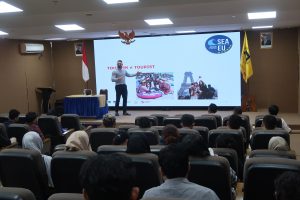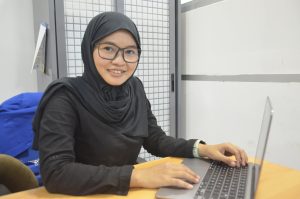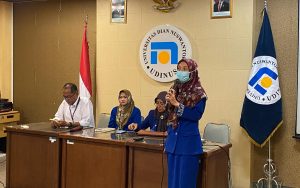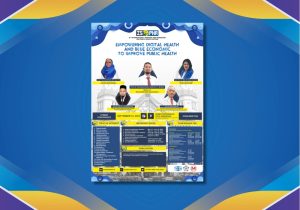Universitas Dian Nuswantoro (Udinus) utilized the Abhirama Exhibition held by the Ranggawarsita Museum to showcase its newest innovations, the Virtual Museum. The innovation was based on the Virtual Reality (VR) technology, and it was designed as the newest learning facility for visitors.
The Computer Science in Art and Culture (CSAC) team at Udinus had previously signed a Memorandum of Understanding (MoU) regarding this project. This Virtual Museum will later showcase various artifacts from the Ranggawarsita Museum in Central Java. Supposedly, there will be roughly 60 thousand artifacts digitized by Udinus. In the first year, around 700 artifacts will be digitized, which is currently scopes 10 percent of it.
Dr. Ahmad Zainul Fanani, S.Si., M.Kom., (the Vice Dean of the Computer Science Faculty and a researcher from the CSAC team) explained that the virtual museum would be 90 percent accurate of the physical artifacts.
“The digitalization process will employ various techniques, including Image Processing, 3D Construction, Photogrammetry, and VR. These techniques are hoped to produce excellent pictures with precision,” he explained.
“In addition to digitalization, the broken parts of the artifacts can also be fully shown in 3D by implementing the 3D Construction and Photogrammetry technique,” he stated.
The project is currently handled by the CSAC team at Udinus. It also partners with the Information Technology and Educational and Cultural Communication Development Center of Central Java (BPTIK).
“Hopefully, this innovation can be a learning media for students and the public alike. This will eventually allow the artifact to be properly documented. We also involve the regional government and the Ranggawarsito Museum to work on this innovation,” the vice dean explained.
Artifacts Digitalization
The Abhirama Exhibition was participated by 17 participants with the majority being Indonesian Museums. The exhibition took place from June 12th to 16th, 2024. At the exhibition, Udinus and the BPTIK of Central Java showcased numerous innovations, namely, VR Borobudur, the Sekar Nuswantoro Gamelan Robot, and the E-Gamelan of Udinus.
Uswantun Hasanah, S.Pd., M.Pd., (the Head of the Education and Culture Service of Central Java) also tried the Virtual Museum, which is currently undergoing its early development stage. She also appreciated the efforts taken by Udinus in preserving Indonesian artifacts, particularly at the Ranggawarsita Museum. According to her, the virtual museum was a major innovation.
“This innovation can indeed serve as a learning media for students. The absent visitors can also get to know the artifacts in this museum quickly. The technology employed in this virtual museum is also precise and intriguing for the public to learn Indonesian history,” she concluded.
With this virtual museum, the public is expected to be aware of Indonesian history. This virtual museum is also a way for Udinus to positively contribute to the education sector and preserve Indonesian culture. (Humas Udinus/Alex. Foto: Humas Udinus)







